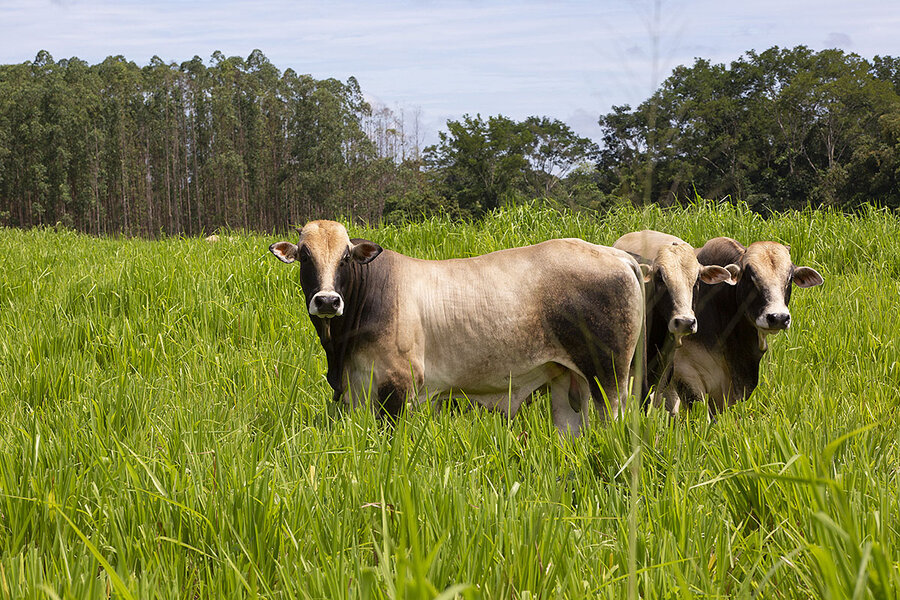Deforestation isn't helping farmers in Brazil. So what might?
Loading...
| Brasilia
Brazilian agribusiness is losing up to $1 billion dollars a year as rising deforestation cuts rainfall in the southern Amazon – a problem set to expand if forest loss continues, a group of Brazilian and German researchers have warned.
In a study published in the journal Nature Communications in May, they found that smaller-scale forest losses can enhance rainfall on adjoining agricultural land – but once losses pass 55-60%, rainfall plunges.
Losses of tree cover in particular seem to delay the start and shorten the length of the rainy season, they found.
As Brazilian Amazon forest destruction continues, drier conditions could put a massive strain on the region’s mainly rainfed agricultural industry, the authors said.
Brazil is the world’s top soybean producer, and its second largest producer of beef, as well as the globe’s biggest beef exporter.
In parts of the country, Brazil’s farmers are already battling unusually dry weather this year, with government agencies warning in late May of drought threats as the country faces its worst dry spell in 91 years.
In the southern Amazonian state of Mato Grosso, Brazil’s main soy producer, irregular rainfall is reducing potential harvests, according to the Mato Grosso Institute of Agricultural Economics.
Aprosoja Brasil, the country’s main soy production association, similarly said farmers faced drought while planting last October and November, followed by excessively heavy rain at harvest time this year, lowering the expected harvest.
The new study looked at rainfall changes between 1999 and 2019 in the southern Brazilian Amazon, a 1.9 million sq km area that has so far lost about a third of its forests, as a model for future rainfall shifts.
Researchers predicted what might happen through 2050 under continued weakening of Brazil’s conservation policies and strong political support for agricultural expansion compared to effective enforcement of forest protection laws.
Co-author Britaldo Soares told the Thomson Reuters Foundation that the difference was stark.
Unless Brazil’s government quickly shifts its pro-development policies, which favor economic growth over conservation, agribusinesses could become victims of the measures many of them support.
The effect would be like “shooting yourself in the foot,” said Mr. Soares, who is project coordinator for the Centre for Remote Sensing at the Federal University of Minas Gerais.
Environmentalists say President Jair Bolsonaro’s policies have weakened conservation efforts and his rhetoric has emboldened illegal ranchers, loggers, and land speculators to cut down the Amazon forest to expand their business.
Mr. Bolsonaro’s office did not respond to a request for comment.
More forest loss
Amazon forest losses have soared to a 12-year high since Mr. Bolsonaro took office in 2019, with deforestation rising 43% in April compared to the same month a year ago, according to government data published in May.
Removing trees to plant crops and raise cattle reduces the forest’s ability to trap and store planet-heating carbon dioxide in the atmosphere, and can contribute to emissions if forests are burned.
But more fragmented forest, as losses grow, also is less able to produce the same volume of water vapor that rises to become rain, and can make the forest drier and more vulnerable to burning.
Less rainfall can mean lower yields and force farmers in the southern Amazon and beyond to adapt by moving to new areas or growing more drought-resistant crops, the study noted.
It did not discuss prospects for irrigating crops in the region.
Farmers in the Amazon also commonly profit from double-cropping, or growing at least two crops per year.
But that could become more difficult or impossible if continuing tree losses cause rainy seasons to become delayed and shorter, the study noted.
Researchers said that if Brazil’s government fails to act against deforestation, international responses – including potential sanctions and exclusion of Brazil from international treaties – could also result in lost revenue for Brazil’s farm-related businesses.
Stopping forest loss in the Amazon is vital not only to protect biodiversity and the global climate but to protect agribusiness itself, they said.
New model
As part of their study, the researchers used mathematical modeling to predict the economic losses that southern Amazonian agribusiness is expected to suffer if current policies continue and rainfall in the Amazon keeps dropping.
By 2050, the beef industry could lose more than $180 billion and the soy industry up to $5.6 billion in total due to the effects of decreased rainfall, the study found.
Mr. Soares said for long-term economic prosperity the Amazon region needed to find a more sustainable economic model not reliant on land-hungry commodities such as soy and beef whose expansion was leading to major forest loss.
A study he and other researchers carried out in 2018 found landowners could potentially earn more than $700 per hectare each year in international payments to keep climate-stabilizing forests standing as well as by created processed products from forest species such as Brazil nuts.
Cattle ranching on deforested land, by comparison, earns a landowner about $40 per hectare each year, it noted.
Brazil also needs better enforcement of its forest protection laws to preserve conservation zones and indigenous territories, he said.
As well, other nations need to put more pressure on the current Brazilian government to boost forest conservation, said Paulo Barreto, a researcher who has studied the Amazon for three decades and works at the nonprofit research institute Imazon.
That should include “immediate and concrete measures” such as refusing to purchase beef, soy, or other products from deforested land, he said.
Argemiro Teixeira, one of the study’s co-authors and an environmental systems modeler, said profitable agriculture and forest protection in the Amazon did not have to be at odds.
Agribusiness can be profitable without continued expansion at the expense of the forest, he noted, calling it “possible and necessary to improve the industry while preserving the environment.”
This story was reported by the Thomson Reuters Foundation.








